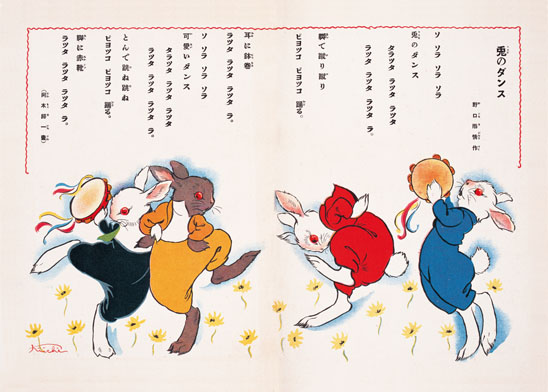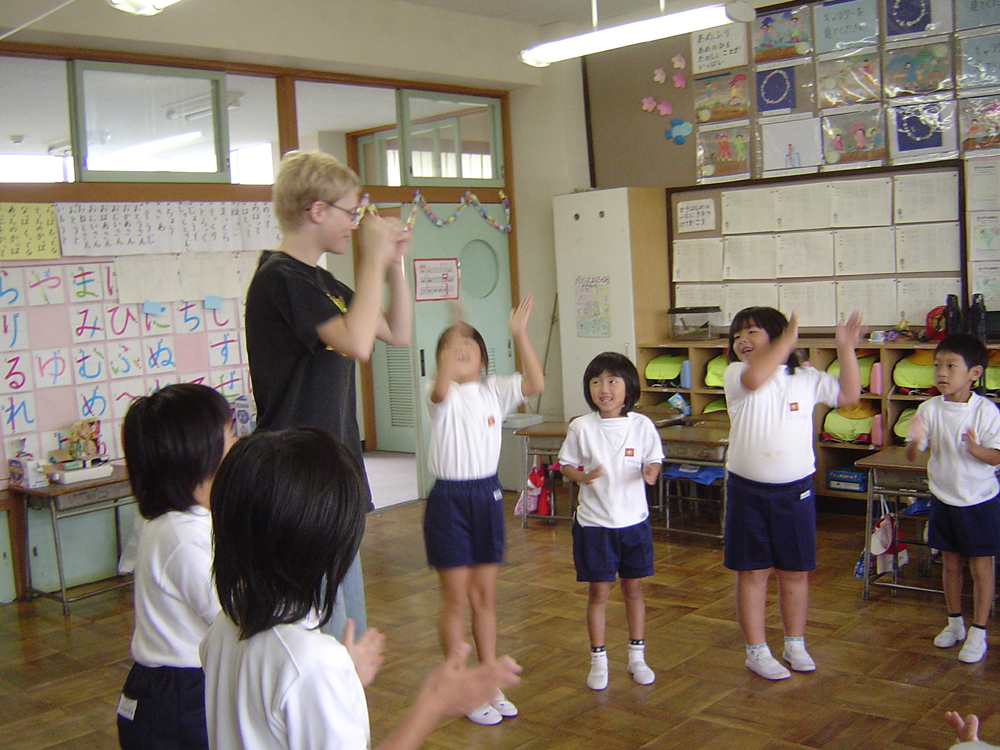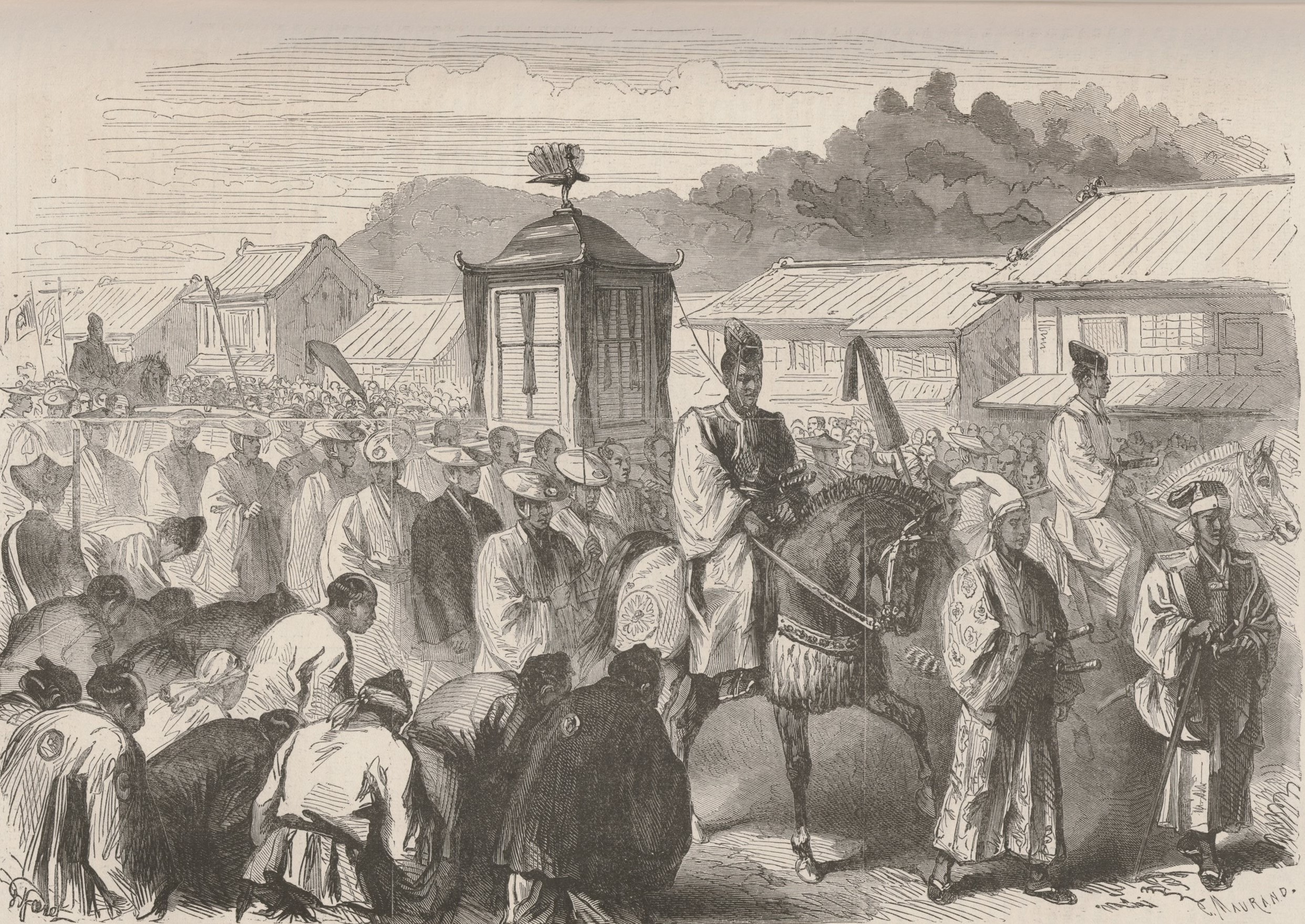|
Shabondama
(lit. "Soap Bubbles") is a Japanese nursery rhyme written by Ujō Noguchi in 1922. It is widely taught in Japanese nursery schools and kindergartens as a simple melody; it is also sometimes used in elementary school moral education courses, where students learn that it is a meditation on the death of a child. Noguchi's daughter Midori died at the age of just 7 days in 1908. In the Meiji period, the infant mortality rate was quite high and 20 to 30 percent of children died before reaching schooling age. It was common to have many children to aim for success of the household, but Noguchi was divorced, and he thus mourned the loss of his only child for a long time. It is widely believed that Noguchi, seeing the girls in his village play with bubbles, was reminded of the brief existence of his daughter, and wrote this poem on that occasion. However, other than the above facts, the direct inspiration for the song is unknown. The tune is a modification of the Christian hymn " Jesus Lov ... [...More Info...] [...Related Items...] OR: [Wikipedia] [Google] [Baidu] |
Ujō Noguchi
was a Japanese poet and lyricist of children's songs and traditional Min'yō folk music. He wrote some of the most beloved and familiar pieces for children and youth choirs, such as "Akai Kutsu (Red Shoes)". He, along with Hakushū Kitahara, and are considered to be the three great poets and children's songwriters in Japan. Early life Ujō Noguchi was born , encyclopedia, vol.17, 645, article for 「のぐちうじょう」by Michio Namekawa ( :ja:滑川道夫) or 栄吉,, p.159- in the former town of Isohara, Ibaraki, which is now incorporated into the central part of Kitaibaraki, Ibaraki, Kitaibaraki city. He was the eldest son of , a cargo-shipping wholesaler, and . Eikichi was born into a prestigious family that claimed its descent from Kusunoki Masasue, the younger brother of Kusunoki Masashige.) After completing his 4-year elementary and 4-year senior elementary schooling in his home town, the teenage Eikichi moved to the capital in 1897, where he attended Tōkyō Mid ... [...More Info...] [...Related Items...] OR: [Wikipedia] [Google] [Baidu] |
Nursery Rhyme
A nursery rhyme is a traditional poem or song for children in Britain and many other countries, but usage of the term dates only from the late 18th/early 19th century. The term Mother Goose rhymes is interchangeable with nursery rhymes. From the mid-16th century nursery rhymes begin to be recorded in English plays, and most popular rhymes date from the 17th and 18th centuries. The first English collections, '' Tommy Thumb's Song Book'' and a sequel, ''Tommy Thumb's Pretty Song Book'', were published by Mary Cooper in 1744. Publisher John Newbery's stepson, Thomas Carnan, was the first to use the term Mother Goose for nursery rhymes when he published a compilation of English rhymes, ''Mother Goose's Melody, or, Sonnets for the Cradle'' (London, 1780). History Lullabies The oldest children's songs of which we have records are lullabies, intended to help a child fall asleep. Lullabies can be found in every human culture. The English term lullaby is thought to come from "lu, l ... [...More Info...] [...Related Items...] OR: [Wikipedia] [Google] [Baidu] |
Nursery School
A preschool, also known as nursery school, pre-primary school, or play school or creche, is an educational establishment or learning space offering early childhood education to children before they begin compulsory education at primary school. It may be publicly or privately operated, and may be subsidized from public funds. Information Terminology varies by country. In some European countries the term "kindergarten" refers to formal education of children classified as '' ISCED level 0'' – with one or several years of such education being compulsory – before children start primary school at ''ISCED level 1''. The following terms may be used for educational institutions for this age group: *Pre-Primary or Creche from 6 weeks old to 6 years old- is an educational childcare service a parent can enroll their child(ren) in before primary school. This can also be used to define services for children younger than kindergarten age, especially in countries where kindergarten is ... [...More Info...] [...Related Items...] OR: [Wikipedia] [Google] [Baidu] |
Kindergarten
Kindergarten is a preschool educational approach based on playing, singing, practical activities such as drawing, and social interaction as part of the transition from home to school. Such institutions were originally made in the late 18th century in Germany, Bavaria and Alsace to serve children whose parents both worked outside home. The term was coined by German pedagogue Friedrich Fröbel, whose approach globally influenced early-years education. Today, the term is used in many countries to describe a variety of educational institutions and learning spaces for children ranging from 2 to 6 years of age, based on a variety of teaching methods. History Early years and development In 1779, Johann Friedrich Oberlin and Louise Scheppler founded in Strasbourg an early establishment for caring for and educating preschool children whose parents were absent during the day. At about the same time, in 1780, similar infant establishments were created in Bavaria. In 1802, Princess ... [...More Info...] [...Related Items...] OR: [Wikipedia] [Google] [Baidu] |
Elementary School
A primary school (in Ireland, the United Kingdom, Australia, Trinidad and Tobago, Jamaica, and South Africa), junior school (in Australia), elementary school or grade school (in North America and the Philippines) is a school for primary education of children who are four to eleven years of age. Primary schooling follows pre-school and precedes secondary schooling. The International Standard Classification of Education considers primary education as a single phase where programmes are typically designed to provide fundamental skills in reading, writing, and mathematics and to establish a solid foundation for learning. This is International Standard Classification of Education#Level 1, ISCED Level 1: Primary education or first stage of basic education.Annex III in the ISCED 2011 English.pdf Na ... [...More Info...] [...Related Items...] OR: [Wikipedia] [Google] [Baidu] |
Meiji Period
The is an era of Japanese history that extended from October 23, 1868 to July 30, 1912. The Meiji era was the first half of the Empire of Japan, when the Japanese people moved from being an isolated feudal society at risk of colonization by Western powers to the new paradigm of a modern, industrialized nation state and emergent great power, influenced by Western scientific, technological, philosophical, political, legal, and aesthetic ideas. As a result of such wholesale adoption of radically different ideas, the changes to Japan were profound, and affected its social structure, internal politics, economy, military, and foreign relations. The period corresponded to the reign of Emperor Meiji. It was preceded by the Keiō era and was succeeded by the Taishō era, upon the accession of Emperor Taishō. The rapid modernization during the Meiji era was not without its opponents, as the rapid changes to society caused many disaffected traditionalists from the former samu ... [...More Info...] [...Related Items...] OR: [Wikipedia] [Google] [Baidu] |
Infant Mortality
Infant mortality is the death of young children under the age of 1. This death toll is measured by the infant mortality rate (IMR), which is the probability of deaths of children under one year of age per 1000 live births. The under-five mortality rate, which is also referred to as the ''child mortality rate'', is also an important statistic, considering the infant mortality rate focuses only on children under one year of age. In 2013, the leading cause of infant mortality in the United States was birth defects. Other leading causes of infant mortality include birth asphyxia, pneumonia, congenital malformations, term birth complications such as abnormal presentation of the fetus umbilical cord prolapse, or prolonged labor, neonatal infection, diarrhea, malaria, measles, and malnutrition. One of the most common preventable causes of infant mortality is smoking during pregnancy. Lack of prenatal care, alcohol consumption during pregnancy, and drug use also cause complication ... [...More Info...] [...Related Items...] OR: [Wikipedia] [Google] [Baidu] |
Jesus Loves Me, This I Know
"Jesus Loves Me" is a Christian hymn written by Anna Bartlett Warner (1827–1915). The lyrics first appeared as a poem in the context of an 1860 novel called ''Say and Seal'', written by her older sister Susan Warner (1819–1885), in which the words were spoken as a comforting poem to a dying child. The tune was added in 1862 by William Batchelder Bradbury (1816–1868). Along with his tune, Bradbury added his own chorus "Yes, Jesus loves me, Yes, Jesus Loves me..." After publication as a song it became one of the most popular Christian hymns in churches around the world, especially among children. Poem by Anna Bartlett Warner As originally published in 1860, it appeared in four stanzas, as follows: Jesus loves me—this I know, For the Bible tells me so: Little ones to him belong,— They are weak, but he is strong. Jesus loves me—he who died Heaven’s gate to open wide; He will wash away my sin, Let his little child come in. Jesus loves me—loves me st ... [...More Info...] [...Related Items...] OR: [Wikipedia] [Google] [Baidu] |
Yumoto Station
is a railway station on the Jōban Line in the city of Iwaki, Fukushima, Japan, operated by East Japan Railway Company (JR East). Lines Yumoto Station is served by the Jōban Line, and is located 201.5 km from the official starting point of the line at . Station layout Yumoto Station has one island platform and one side platform connected to the station building by a footbridge. The station has a ''Midori no Madoguchi'' staffed ticket office. Platforms History Yumoto Station opened on 25 February 1897. The present station building was completed in March 1967. The station was absorbed into the JR East network upon the privatization of the Japanese National Railways (JNR) on 1 April 1987. A new station building was completed in November 2014. Passenger statistics In fiscal 2018, the station was used by an average of 2021 passengers daily (boarding passengers only). Surrounding area * Iwaki Yumoto onsen * Spa Resort Hawaiians * Iwaki Coal and Fossil Museum *Iwaki Po ... [...More Info...] [...Related Items...] OR: [Wikipedia] [Google] [Baidu] |
Iwaki, Fukushima
is a city located in Fukushima Prefecture, Japan. , Iwaki had a population of 337,765 in 143,500 households, and population density of 270 persons per km2. The total area of the city is , making it the largest city in the prefecture and the 10th largest city in Japan (2010) in terms of area. Iwaki is a designated core city, and is also one of the growing number of cities written in ''hiragana''. The present Iwaki City started as the merger of 14 smaller municipalities on October 1, 1966. Every year, Iwaki hosts the Taira Tanabata Festival from 6–8 August. Geography and climate The city is located at the southeastern end of Tōhoku region and borders on Ibaraki Prefecture. The city occupies around 8.9 percent of the total area of Fukushima Prefecture. The eastern part of the city is made up of of coastline which faces the Pacific Ocean and the western part goes through the Abukuma highlands and joins up with the central part of Fukushima Prefecture. The western part is a rang ... [...More Info...] [...Related Items...] OR: [Wikipedia] [Google] [Baidu] |
Fukushima Prefecture
Fukushima Prefecture (; ja, 福島県, Fukushima-ken, ) is a prefecture of Japan located in the Tōhoku region of Honshu. Fukushima Prefecture has a population of 1,810,286 () and has a geographic area of . Fukushima Prefecture borders Miyagi Prefecture and Yamagata Prefecture to the north, Niigata Prefecture to the west, Gunma Prefecture to the southwest, and Tochigi Prefecture and Ibaraki Prefecture to the south. Fukushima is the capital and Iwaki is the largest city of Fukushima Prefecture, with other major cities including Kōriyama, Aizuwakamatsu, and Sukagawa. Fukushima Prefecture is located on Japan's eastern Pacific coast at the southernmost part of the Tōhoku region, and is home to Lake Inawashiro, the fourth-largest lake in Japan. Fukushima Prefecture is the third-largest prefecture of Japan (after Hokkaido and Iwate Prefecture) and divided by mountain ranges into the three regions of Aizu, Nakadōri, and Hamadōri. History Prehistory The keyhol ... [...More Info...] [...Related Items...] OR: [Wikipedia] [Google] [Baidu] |
1922 Songs
Nineteen or 19 may refer to: * 19 (number), the natural number following 18 and preceding 20 * one of the years 19 BC, AD 19, 1919, 2019 Films * ''19'' (film), a 2001 Japanese film * ''Nineteen'' (film), a 1987 science fiction film Music * 19 (band), a Japanese pop music duo Albums * ''19'' (Adele album), 2008 * ''19'', a 2003 album by Alsou * ''19'', a 2006 album by Evan Yo * ''19'', a 2018 album by MHD * ''19'', one half of the double album '' 63/19'' by Kool A.D. * '' Number Nineteen'', a 1971 album by American jazz pianist Mal Waldron * ''XIX'' (EP), a 2019 EP by 1the9 Songs * "19" (song), a 1985 song by British musician Paul Hardcastle. * "Nineteen", a song by Bad4Good from the 1992 album ''Refugee'' * "Nineteen", a song by Karma to Burn from the 2001 album ''Almost Heathen''. * "Nineteen" (song), a 2007 song by American singer Billy Ray Cyrus. * "Nineteen", a song by Tegan and Sara from the 2007 album '' The Con''. * "XIX" (song), a 2014 song by Slipkno ... [...More Info...] [...Related Items...] OR: [Wikipedia] [Google] [Baidu] |



.jpg)




